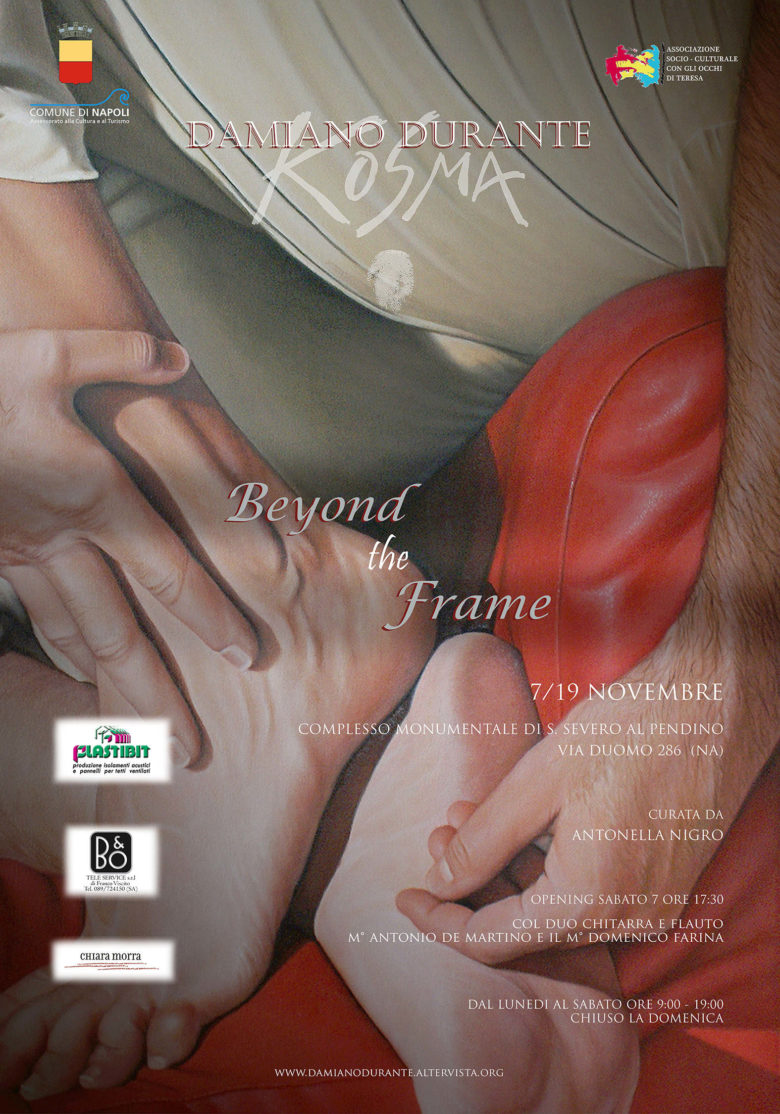Beyond the frame – Complesso monumentale di San Severo al Pendino
Patrocinata dal Comune di Napoli
a cura di Antonella Nigro
Napoli IT, 2015
BEYONDE THE FRAME
Translation from Italian by Cecilia Fiermonte
Usually, artists portray the drive, the love, the passion, the desire, the pain and other feelings that touch our lives. It is a type of egoism that, sometimes, draws in the viewers of their work, other times it misses, not inspiring feeling, nor even sparking interest. The lack of engagement of an exhibition visitor can be readily seen: he browses the works, seemingly beautiful or not, without establishing any discourse, not even with himself, not posing questions, not having, in this way, any appreciation for the artist’s effort to communicate.
With his work, Damiano Durante does something more in order to strike the visitor; it is largely didactic: he invites one to go beyond the narrow space of the canvas, openly stimulating reflection, his realistic technique expressing symbolic content that is an actual inspiration to the visitor. The fusion of symbols, in art, as in cinematography, the photograph and the painting, help the mind enter the physical reality of the representation, almost completing the artist’s work, in that way constructing a discourse within the environment of the painting.
The power of Durante’s painting, on closer examination, concretely touches the five senses: water comes alive and almost takes on consistency, a glass in fragments evokes the sound of shattering, the light in a candle expands beyond its own physical presence, the clinging bodies leads one to understand the feeling of an embrace, a half-empty bottle recalls hidden feelings.
Durante’s still-lifes are more than alive, the physical becomes eternal, the past links to the present, the future is a flower already blossomed. The looming darkness recalls the vulnerability of human existence, the need to search for a universal connection in which doubt and certainty can coexist, the light and dark, water and light, life beyond every form.
Aniello D’Iorio
OLTRE LA CORNICE
Di norma gli artisti raccontano le pulsioni, gli amori, le passioni, i desideri, i dolori e gli altri sentimenti che li segnano nella vita. È una sorta di egoismo che, talvolta, coinvolge i fruitori delle loro opere, altre volte scivola senza indurre emozioni o, almeno, intrigare. La mancanza di partecipazione del visitatore di una mostra si legge con immediatezza: egli scorre le opere, belle o brutte che possano sembrare, non instaurando alcun colloquio neppure con se stesso, non si pone domande, non avendo, in questo modo, alcun rispetto per lo sforzo di comunicazione dell’artista.
Damiano Durante con i suoi lavori fa qualcosa in più per colpire il visitatore; è eminentemente didattico: invita a uscire fuori dello stretto spazio della tela stimolando apertamente la riflessione; la sua tecnica realista esprime contenuti simbolici che sono veri e propri suggerimenti al visitatore. La fusione di segni di arti come la cinematografia, la fotografia e la pittura aiutano la mente a entrare nella materia viva del quadro. Le forme interrotte spingono la mente oltre la fisicità della rappresentazione, quasi a completare l’opera dell’artista, costruendo, in tal modo, un colloquio che ha come humus proprio il dipinto.
Le suggestioni della pittura di Durante, a ben vedere, toccano realmente i cinque sensi: l’acqua diviene corposa e sembra quasi prendere consistenza, un bicchiere in frantumi evoca il rumore secco della frattura, la luce di una candela si espande oltre la sua stessa fisicità, i corpi avvinghiati lasciano intendere gli umori di un abbraccio, una bottiglia semivuota richiama sentori nascosti.
Le nature morte di Durante sono più che vive, i corpi si eternano, il passato si lega al presente, il futuro è in un fiore già sbocciato. Il nero incombente racconta l’esilità dell’esistenza umana, il bisogno di ricerca di un’intimità universale in cui possano coesistere i dubbi e le certezze, il chiaro e lo scuro, acqua e luce, la vita oltre ogni forma.
Aniello D’Iorio


Comments are closed.